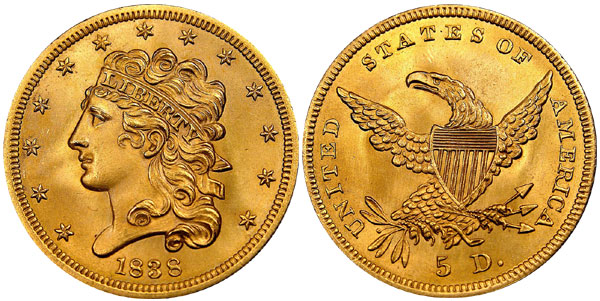Guide to U.S. Classic Head Half Eagles
The Classic Head Half Eagle was struck for a brief period from 1834 to 1838, which coincided with a significant change for the American gold denominations. Both the weight and purity of the denominations was reduced in order to make the bullion value less than the respective face values. During the previous two decades, the majority of freshly minted half eagles had been immediately exported and melted. With the lower gold content, the denomination would have a chance to circulate within domestic commerce. The final year of the series also saw the production of coins at the newly established southern branch mints located in Charlotte and Dahlonega.

Following the discontinuation of the eagle or ten dollar gold piece in 1804, the largest denomination in production became the half eagle with a value of five dollars. The denomination had been struck in reasonable quantities for most years, but was subject to heavy exportation and melting whenever the gold value of the coins exceeded the face value. The Coinage Act of 1834 would bring things back into balance by reducing the precious metal content of the gold denominations and thus allowing them to circulate more readily.
A new design was created for the half eagle by William Kneass to go along with the change in specifications. The obverse design featured a new interpretation of Liberty, with a notably younger appearance. She still appears facing left, but instead of a cap she now wears a simple headband inscribed LIBERTY. Her hair appears in bumpy curls with locks extending over and past the truncation of her neck. Thirteen stars appear evenly spaced around the portrait with the date positioned below.
The reverse design remained similar to the previous type, featuring a bald eagle seen from the front with its wings spread. The eagle has a shield at its breast and holds an olive branch and bundle of three arrows in its talons. The inscription UNITED STATES OF AMERICA appears around, with the first and last word separated by the tips of the eagle’s wings. The denomination appears directly beneath the eagle, expressed as “5 D.” The one significant change to the previous reverse design was the removal of the motto E PLURIBUS UNUM, which had appeared on a scroll above the eagle.
A little over a month after the approval of the change in specifications on June 28, 1834, the Philadelphia Mint struck and paid out the first of the new half eagles. By the end of the year, the total output from the Philadelphia Mint would reach 657,460 pieces, almost triple the highest annual mintage for the denomination up until this point. While production levels would decline over the next few years, the output and extent of circulation was much higher than the Mint had anticipated. As such, the change in specifications could be considered a success.
The Classic Head Half Eagles were struck at the southern branch mints for two different issues during the final year of the series. The mints located in Charlotte and Dahlonega would both produce a limited number of half eagles, which were among the first United States coins to carry mint marks. The mintages for the two issues would be significantly lower than the production levels reached at the Philadelphia Mint, creating two key dates for the short-lived series.
An extremely small number of proof strikings were produced for the series, made as presentation pieces or at the request of influential coin collectors. The first year for the series in 1834 is represented by approximately six proofs, with three to four proofs believed to exist for the years 1835 to 1836. The final years of the series from 1837 to 1838 are each represented by only a single known proof specimen, although the status for the final year is disputed.

